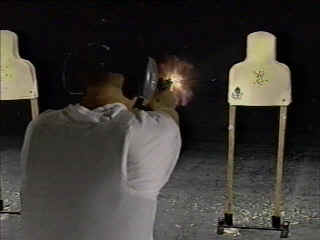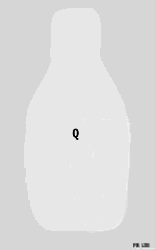

The Handgun Qualification Trap Are Handgun Qualification Procedures Leaving Police Agencies Vulnerable To Legal Challenge?
June 2002
Muddled
Methodology & Terminology In law
enforcement lexicon, the term “qualification” was long used
interchangeably with the word “training.” That in itself has caused
trainers heartburn, as many agency administrators truly believed they
were “training” officers while only meeting minimal, externally mandated
firearms qualification standards. Yes,
things are improving. What is emerging, though slowly, is the
recognition that firearms training must be addressed within
task-oriented contexts. Call it role-playing, scenario-based training,
or any other reasonable facsimile you’d like, the “when” and “where” to
use firearms is finally being seen as being as essential as the “how”
issue of using a firearm.
Using the “when” and “where” issues as a backdrop, I’d like to address a
widely ignored issue that is likely to haunt the law enforcement
community if not eventually addressed.
The
firearms qualification regimen doesn’t serve the “when” or “where”
issues of deadly force application, nor should it. I would concur with
those who argue that firearms qualification is primarily a mechanism by
which we measure baseline marksmanship competency. However, traditional
firearms qualification procedures have, perhaps unwittingly, provided
some indefensible “when” and “where” variables. Take
the issue of the range parameters applied to the majority of police
firearms qualification courses of fire. Yes, they have been truncated
over the last decade, from the 50-yard variety, to an almost universal
25-yard variety. I attribute some of the impetus for elimination of
50-yard qualification standard to the mass inception of semi-automatic
pistols into police service.
The 25-yard courses of fire still represent a vestige
of thinking that one would be very hard-pressed to defend in a court of
law, when (not if) the issue is finally raised. Yes, this may still be
controversial ground to stand upon, but please bear me out a bit
further. I’ll delineate specific issues that warrant detailed
examination. Issue #1 Most officers
score poorly with the rounds fired beyond 15 yards.
Many would ask, “So what’s the big deal?” Of the
thousands of officers I’ve trained, the blatant trend noticeable in the
bulk of “firearms-marginal” police officers is a tendency to “load-up”
their scores at ranges inside 15 yards, thereby affording themselves the
“wiggle-room” to drop rounds at the 25 yard line. In fact, it isn’t
uncommon to see firearms instructors reminding officers that scoring
well at close range takes the pressure off of the officer at 25 yards.
Many might still ask whether this issue amounts to
anything substantive. In short, it does. The implications of having
officers qualify at 25 yards are critical ones. They are as follows:
(1)
Successful completion of the 25-yard qualification course
suggests competency at this distance.
(2)
The frequency of shots misplaced at the 25-yard stage of
qualification courses implies incompetence at that distance.
(3)
“Qualification” at 25 yards implies that the agency endorses the
application of deadly force with the issued handgun at this distance.
This in turn implies deliberate indifference to the fact that many or
most officers are not competent at that distance.
This isn’t a stretch of reason, nor is it merely the
product of hypothetical paranoia of a police policy analyst. And, there
is yet more to consider. Issue #2
Proximity, and the
Justification of Deadly Force Application
When we train officers to recognize the emergence of
an imminent lethal threat, we discuss the dynamics of threat imminence.
The nature of the suspect’s (1) ability, (2) opportunity and (3) intent
are illuminated for this purpose. Inherent within the context of
“ability” and “opportunity” is the issue of proximity. Suspects armed
with anything less than a firearm are deemed NOT to be imminent
threats at 25 yards. Additionally, we teach that distance = time, and
that time = alternatives to deadly force application. I would also
submit to you that, given published police gunfight hit probability,
expending rounds at 25 yards in most suburban and urban settings defies
logic articulable to the unwashed masses. But there’s more to consider. Issue #3
Exacerbation of Threat
Identification Problems
There remains this one little sticky issue that makes
the issue of “distanced” deadly force application all the more salient;
adverse lighting conditions. As many officers and trainers are painfully
ware, at least 6 in every 10 gunfights occur under diminished lighting
conditions.
Worse yet, given the
frequency in which shootings occur in low light, and the infrequency
in which officers get any low light “qualification,” the daylight
qualification becomes the de facto “all-purpose” qualification.
Having said that, and knowing that my research is showing 23-30%
declinations in hit ratios at night, why on earth are we exacerbating
the problem by promoting the falsehood of 25-yard qualifications?
According to our research, substantive
cognitive impairment occurs at light thresholds consistent with dawn or
dusk light conditions. It needn’t be “dark” for officers to experience
difficulty in discerning weapons from more innocuous objects. In fact,
and it should come as no surprise to anyone, that 71% of “questionable”
police shootings (e.g., when the suspect was unarmed and non-assaultive)
occur under diminished light conditions. The point?
Distance serves to further exacerbate the issue of threat
identification, even more so in low light. A More Sensible
and Defensible Approach
There is a silver lining to this thesis. Simply stated, it is that we
can solve several residual problems with one streamlined, progressive
approach. By implementing a close-proximity (12 yards and in) qualification standard, we can also implement a “zero-tolerance" miss standard. That’s right, a “100% hit standard”, at distances that better reflect street realities. For example, if you implement a 20-round qualification course, with firing stages at 3-5-7-10-12 yards, utilizing the imperfect but ubiquitous FBI “Q” Target, your officers would have to have ALL 20 rounds accounted for in the bottle-shaped scoring area. Anything out of that area would be a “fail.” A 100% qualification standard implies that even your marginal shooters were competent at all stages fired. It also
side-steps the often ballyhooed controversy regarding a “pass-fail”
qualification standard. If your score is “perfect,” you
pass, if not, you don’t. It is this system perfect? Nothing will be,
though this will represent a quantum leap for most agencies.
FBI/DEA “Q”
Target All shots fired for score are required to fall within the “bottle” scoring area to qualify under “zero-tolerance" miss standard.
Put yourself
in an adversarial position; which would you rather challenge, the
established competency of officers with an agency with a 100%
qualification standard, fired at "real-world distances", or one
in which the agency accepted its officers missing (yet “qualifying”)
20-30% of the time? Some
might ask, “But, won’t this raise expectations that our officer’s shot
placement will have to be ‘perfect’ in a gunfight?” There is an
ever-growing body of scientific evidence that illuminates why even
accomplished shooters perform poorly under periods of high stress. The
old gunfighter’s axiom, “In a gunfight, you’ll only do half as well as
your best day in practice” might not have been based on empirical
research, but it retains optimistic plausibility to this day. Am I
suggesting the elimination of ALL handgun training beyond
12 yards? Negative! Notice that I have purposely employed the
word “training.” Firing drills at distances greater than 12 yards can be
beneficial. Although a statistical aberration, there are police handgun
shootings beyond 12 yards. They have generally comprised roughly 5% of
all police confrontations. In addition, officers should (if training
resources allow) learn the limitations of their marksmanship ability,
even if only under the sterile conditions of a range. If an officer is
confronted with an articulable, real-world lethal threat beyond 12
yards, he/she should have some familiarization with the application.
In Summary
Yes,
if trainers were to be given sufficient resources (time, money,
equipment, range access, etc.), many of the marksmanship problems I have
alluded to could be mitigated. I would proffer that whatever resources
might be expended to facilitate 25-yard handgun competency would be more
judiciously expended elsewhere. Until we can cultivate substantially
greater handgun competence at distances inside of 7 yards, I would argue
that everything else (pertinent to the “qualification” issue) is
secondary. Most
trainers will recognize many of these issues to be self-evident. Yet,
police standards and training bureau’s (generally at the state level)
seem resistant to change. Perhaps it’s time we lobby them for change,
before there are substantive consequences. As
an essential footnote, address adverse light qualification as a separate
entity. From my observations of thousands of students during my former
tenure at Smith & Wesson Academy, I have concluded that low light
qualification of street officers should NOT be conducted beyond 7
yards. In addition, the 5 and 7-yard stages must be flashlight
augmented. Can we afford to cling to tradition as a means of forestalling the compelling need to address deficient training/qualification practices? Thomas J. Aveni is a staff member of the Police Policy Studies Council (http://www.theppsc.org). Mr. Aveni was a member of the Smith & Wesson Academy staff from 1990-2001. He is a career police officer, having served as a sworn officer in three different states, on state and local levels. He invites your comments and input. He can be e-mailed at: tom@theppsc.org. ©2004 The Police Policy Studies Council. All rights reserved.
|

